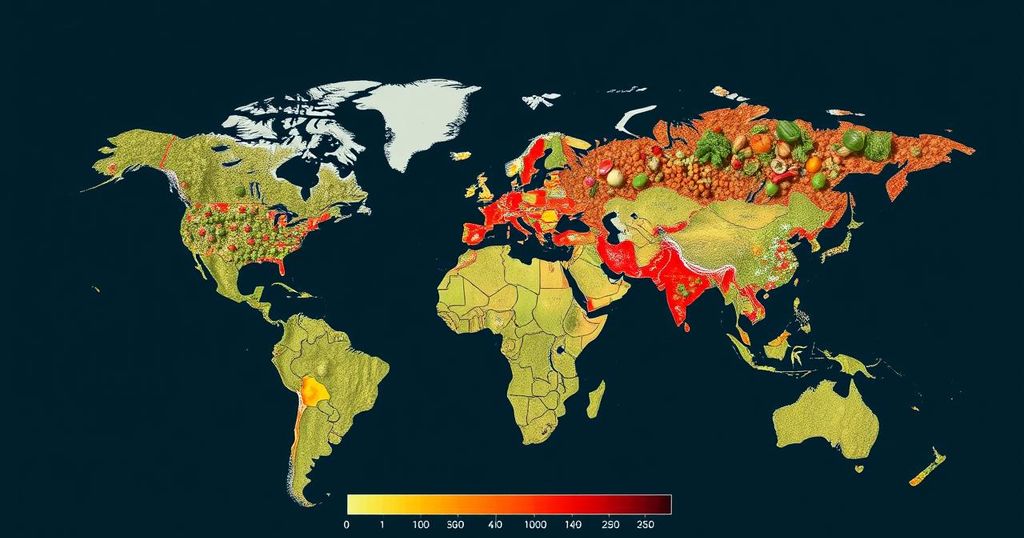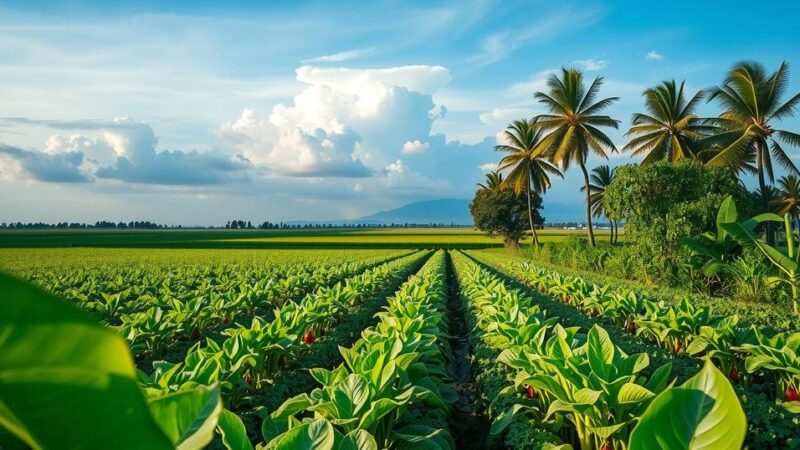The global food price index has hit a record high of 124.4 points as of last September, with previous peaks of 160.2 in March 2022. Severe climate changes and geopolitical events, including the conflict in Ukraine and shipping disruptions, have driven this increase. Essential commodities such as wheat, coffee, and cocoa have seen significant price surges, influenced by droughts, supply chain issues, and inflation. In the U.S., food prices have risen by 28%, while food manufacturers’ profits have also increased, illustrating a complex economic landscape.
The global food price index has reached unprecedented levels, primarily influenced by severe climate changes and ongoing geopolitical tensions. Since September 2019, when the index registered at 93.4 points, it has skyrocketed to an all-time high of 160.2 in March 2022, before decreasing slightly to 124.4 points by last September, marking it as the highest point in a decade. The index encompasses key sectors, including vegetable oils, grains, sugar, meat, and dairy products. The surge in food prices is largely attributed to extreme weather events linked to climate change and geopolitical unrest. Notably, the prolonged shipping disruptions caused by Houthi attacks in the Red Sea are currently exacerbating food costs. In addition, the Russian invasion of Ukraine has had a profound impact on the market, pushing grain prices to record levels. Although these prices have receded somewhat, they still remain extraordinarily high when compared to historical data. In tracking the record highs of food pricing, it is noteworthy that the United Nations has monitored food costs since 1961. The inflationary spikes observed in 1974 and 1975, following the oil crisis of 1973, served as a critical benchmark; however, the current price levels, in real terms, are higher than those previous records. Climate-related disruptions such as droughts and floods have severely affected various food supplies globally, impacting essential products like wheat, olive oil, and seafood. For instance, olive oil prices in the European Union have surged 45% over the past year due to supply constraints. Wheat prices have increased by 12% since September 2019, reaching $5.40 per bushel. Coffee prices have experienced a staggering 301% rise, hitting a 13-year peak of approximately $2.70 per pound, while cocoa prices have likewise soared to around $7,000 per ton, doubling since 2019. This dramatic increase in cocoa is mainly the result of a drought impacting West Africa, responsible for 80% of global production. Additionally, the COVID-19 pandemic, emerging at the end of 2019, has dramatically influenced food prices. Lockdowns created a surge in demand while simultaneously hindering production processes. The war in Ukraine further strained the situation, particularly with grain and vegetable oil prices. In the EU, food inflation peaked at 19.2% in March 2023, although it has since stabilized at approximately 1.8%. In the United States, food costs have escalated by 28% since 2019 due to increased operational expenses, supply chain issues, and higher profits among food companies. Rising fuel prices have added to the operational costs, alongside increased labor expenses. Notably, beef prices reached record highs in February 2022. Currently, they remain 6.5% higher than levels prior to September 2019, reflecting persistent issues within the cattle industry due to drought and high grain prices. Meanwhile, food and beverage manufacturer profits have surged, with recent reports indicating revenue exceeding expenses by over 7% in 2023, a stark contrast to the challenges faced by consumers in the market.
The current state of global food prices is intricately linked to both climate change and geopolitical tensions, creating a landscape of economic instability. The historical context regarding the United Nations’ food price index indicates significant inflationary trends over the decades, particularly during times of global crises such as the oil shocks of the 1970s. The escalation in prices seen in recent years has broad implications on supply chains and consumer affordability around the world, marked by the impact of the COVID-19 pandemic and the geopolitical volatility stemming from the conflict between Russia and Ukraine. These factors have collectively disrupted food production, leading to shortages and spiking costs across essential commodities.
In conclusion, the global food price index reflects a critical situation driven by exacerbated climate conditions and geopolitical conflicts, with current prices reaching decade-high levels. Continuous challenges such as droughts and geopolitical hostilities necessitate close monitoring of market trends and consumer impacts, while also questioning the sustainability of food supply models. The interplay between operational costs, global events, and consumer pricing underscores a complex landscape wherein the effects of climate and conflict are deeply intertwined. Looking ahead, it will be crucial for stakeholders in agriculture and policy-making to address these multifaceted challenges to stabilize food prices and ensure food security for populations worldwide.
Original Source: www.calcalistech.com






